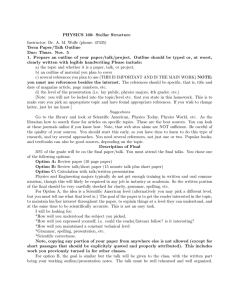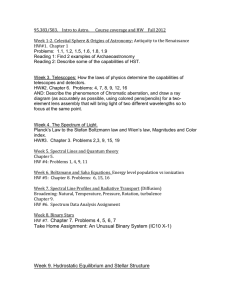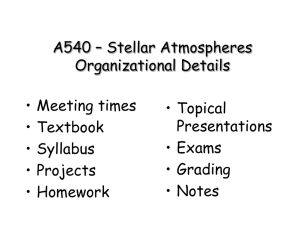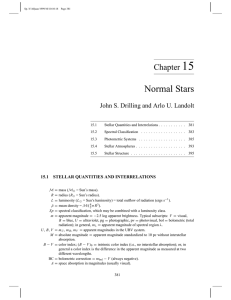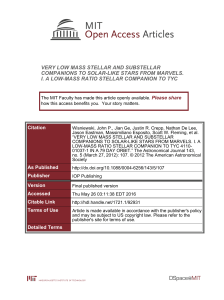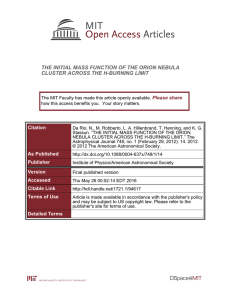Stellar Phenomenology and Stellar Properties •
advertisement
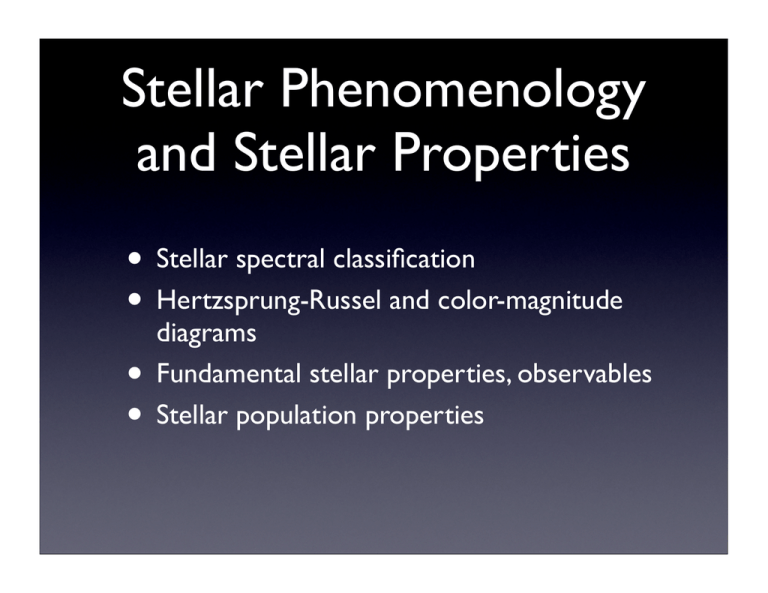
Stellar Phenomenology and Stellar Properties • Stellar spectral classification • Hertzsprung-Russel and color-magnitude • • diagrams Fundamental stellar properties, observables Stellar population properties infrared spectra visible spectra Spectral Classification: Temperature 2 Spectral Classification: Temperature Weak Ca+ T Y 1,400–2,500 K none Molecules: H2O, hydrides reddest star-like objects 400–1,400 K none Molecules: H2O, CH4 none Molecules: H2O, CH4, NH3 <400 K ~ 0.1 10–5–10–3 >100 Gyr <0.08 ~ 0.1 10–6–10–5 N/A <0.08 ~ 0.1 <10–6 N/A Stellar Classification: Temperature Sun stars (G dwarf) M dwarf 5700 K ~3500 K brown dwarfs planets L dwarf T dwarf Jupiter ~2000 K ~1000 K 160 K 4 Spectral Classification: Luminosity • luminosity, radius, surface gravity, and surface pressure are mutually related – L = 4πR2σTeff4, g = GM/R2, P = ρgl (l is photon m.f.p.) • define “luminosity spectral class” V: dwarfs, log g ~ 4.5 [cgs units] IV: subgiants, log g ~ 3 (approximately as on Earth) III: giants, log g ~ 1.5 II: (bright) giants, log g ~ 0.5 I: supergiants, log g ~ –0.5 • Sun: G2 V star (Teff = 5777K, log g = 4.43) (figure from D. Gray) Hertzsprung -Russell (H-R) Diagram • log L vs. log Teff • main sequence: – locus of most stars – bulk of stellar lifetimes – L ∝ M3.8 – τMS ≈ 1010 yr (M/MSun)–2.8 Color-Magnitude Diagram (CMD) • proxy for the (Teff-L) Hertzsprung-Russell diagram • e.g., B–V vs. MV, J–K vs. MK, etc. 8 Stellar Abundances • • • • derived from spectral lines compared to the Sun or to abundance of hydrogen (H) in star–or both a.k.a., “metallicity” “metal-poor” stars, a.k.a. “subdwarfs” are hotter than dwarfs of same luminosity [Fe/H] = log [n(Fe) / n(H)]* – log [n(Fe) / n(H)]Sun Stellar Populations • • Population I: low galatic scale heights, rotate with galactic disk, similar composition to Sun Population II: large scale heights, high space velocities, low mass: old stars • • Star Clusters Messier 80 • • • Pleiades globular clusters (e.g., M80: Pop II stars, gravitationally bound, dense open clusters (e.g., Pleiades): Pop I stars, gravitationally bound, < 2 Gyr “O-B” associations: loose, not gravitationally bound, < 20 Myr Stellar Phenomenology and Properties • Stellar spectral classification • Hertzsprung-Russel and color-magnitude • • diagrams Fundamental stellar properties, observables Stellar population properties Spectroscopic Binary (a) • double-lined (SB2) – spectra of both stars visible (d) (a) (b) (b) (c) (c) (d) • single-lined (SB1) – only spectrum of brighter star visible 13 Radial Velocity vs. Time for Doublelined SB in a Circular Orbit Totally Eclipsing Binaries ta – start of secondary ingress tb – end of secondary ingress tc – start of secondary egress td – end of secondary egress Luminosity-mass relation for binary stars with welldetermined orbits Data from Popper (1980; ARA&A 18, 115) Mass vs. Teff Taking the Stellar Temperature Teff • (Fe II λ5317 / Fe I λ5328) line ratio decreases with decreasing Teff Energy Generation: p-p Chain Initial Mass Function • ξL ≡ dN / (dlog M/MSun) ∝ ∝ (M/MSun)–Γ • ξ ≡ dN / (d M/MSun) ∝ (M/MSun)–α • slope Γ ≡ α + 1 log M/MSun Kroupa (2002) Single Star Fraction • lower mass stars are more commonly single Lada (2006)
